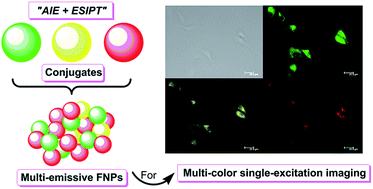Multi-color cell imaging under identical excitation conditions with salicylideneaniline analogue-based fluorescent nanoparticles†
Abstract
Six salicylideneaniline (SA) derivatives are synthesized through a condensation reaction. Benefiting from their coplanar molecular conformation and intramolecular hydrogen bonds, three of the compounds are found to exhibit aggregation-induced emission (AIE) or aggregation-induced emission enhancement (AIEE) behavior after self-assembling into nanoparticles that have a diameter of about 50 nm. Based on the excited-state intramolecular proton transfer (ESIPT) properties, these fluorescent nanoparticles (FNPs) display green, yellow or orange colors due to the formation of H- or J-aggregates. Interestingly, FNPs derived from BMSpP show green to green-yellow fluorescence because of the partial transformation of H-aggregates to J-aggregates. Under neutral conditions (pH = 7.4), these FNPs are stable, with the fluorescence intensity decreasing by less than 20% after 120 min, compared to a rapid reduction at pH 5.5. Importantly, a two-photon fluorescence property of FNPs originating from salicylideneaniline or its derivatives is reported for the first time. The two-photon absorption cross-sections of the green, yellow and orange FNPs are found to be 7, 38 and 27 GM, respectively. After conjugation with phospholipids, these FNPs show good water solubility and low cytotoxicity, which make them potential candidates for cell imaging applications. Finally, multi-color cell imaging under identical excitation conditions with single-emissive and multi-emissive FNPs has been achieved. These results are significant for the control of the one- or two-photon fluorescent properties of such derivatives, and provide a promising platform for multi-color cell imaging applications.


 Please wait while we load your content...
Please wait while we load your content...